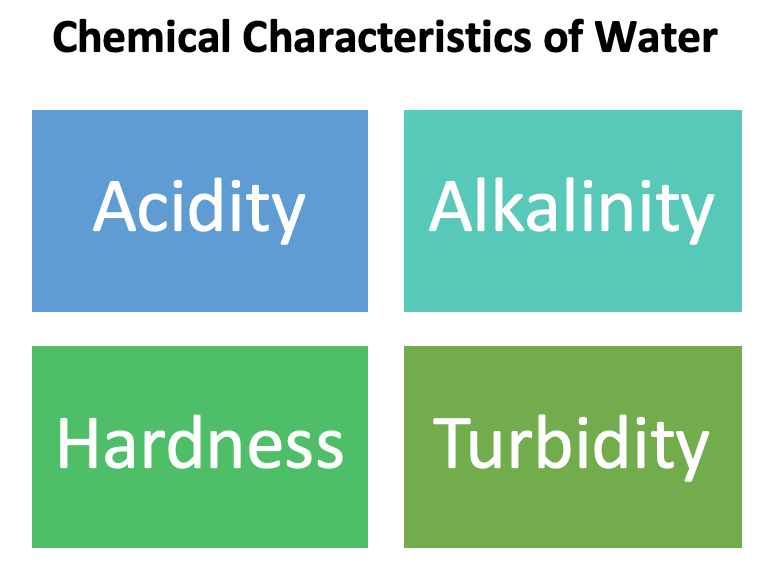Chemical Characteristics of Water

The chemical characteristics of natural water are a reflection of the soils and rocks with which the water has been in contact. In addition, agricultural and urban runoff and municipal and industrial treated wastewater impact the water quality. Microbial and chemical transformations also affect the chemical characteristics of water. The chemical Characteristics of Water can be categorized as below:
- Acidity
- Alkalinity
- Hardness
- Turbidity
Acidity of Water:
pH is a measure of how acidic or basic (alkaline) the water is. It is defined as the negative log of the hydrogen ion concentration. The pH scale is logarithmic and ranges from 0 (very acidic) to 14 (very alkaline). For each whole number increase (i.e. 1 to 2) the hydrogen ion concentration decreases tenfold and the water becomes less acidic. Acidity or alkalinity is measured by pH. PH measures the concentration of Hydrogen ions in water. The ionization of water is:
HOH H+ + OH-
In neutral solutions [OH] = [H] hence pH = 7
If acidity is increased, [H] increases and pH reduces from 7 (because H is log of [H]). The value of the pH of water is important in the operations of many water and wastewater treatment processes and in the control of corrosion.
Alkalinity of Water:
The alkalinity of natural water is generally due to the presence of bicarbonates formed in reactions in the soils through which the water percolates. It is a measure of the capacity of the water to neutralize acids and it reflects its buffer capacity. It may also be attributed to the presence of carbonates and hydroxides. Alkalinity is important for fish and aquatic life because it protects or buffers against rapid pH changes. The values of pH higher than 7, show alkalinity. The alkaline species in water can neutralize acids. The major constituents of alkalinity (or causticity) are OH-, CO32-, and bicarbonate HCO3 ions. Alkalinity in water is usually caused by bicarbonate ions.
Hardness of Water:
Definition of hard water
The hardness of water is merely due to the salt of calcium and magnesium. Temporary hardness is due to carbonate and bicarbonate of calcium and magnesium while permanent hardness is due to chloride and sulfate of calcium and magnesium.
Hardness is the property that makes water require more soap to produce a foam or lather. The hardness of water is not harmful to human health but can be precipitated by heating so can produce damaging effects in boilers, hot pipes, etc by depositing the material and reducing the water storage and carrying capacity. Absolute soft water on the other hand is not acceptable for humans because it may cause ailments, especially to heart patients. Hardness in water is commonly classified in terms of the amount of CaCO3 (Calcium Carbonate) in it.
| Concentration of CaCO3 |
Degree of hardness |
|
0 – 75 mg / L |
Soft |
|
75 – 150 mg / L |
Moderately hard |
|
150 – 300 mg / L |
Hard |
|
300 up mg / L |
Very Hard |
Table 1 - Degree of Hardness
A low level of hardness can be removed just by boiling but a high degree of hardness can be removed by the addition of lime. This method has also the benefit that iron and manganese contents are removed and suspended particles including micro-organisms are reduced.
Also See: Chemical Characteristics of Waste Water
Hard water is not suitable for industrial use. But hard water is usually beneficial for drinking purposes. However, hardness caused by MgSO4 give some serious health effects. So, the concentration of Mg++ should not exceed 50 mg/lt in drinking water.
Turbidity of Water:
Turbidity is a measure of the light-transmitting properties of water and is comprised of suspended and colloidal material. It is important for health and aesthetic reasons. The transparency of natural water bodies is affected by human activity, decaying plant matter, algal blooms, suspended sediments, and plant nutrients. Turbidity provides an inexpensive estimate of total suspended solids (TSS) concentration. It has little meaning except in relatively clear waters but is useful in defining drinking-water quality in water treatment.












